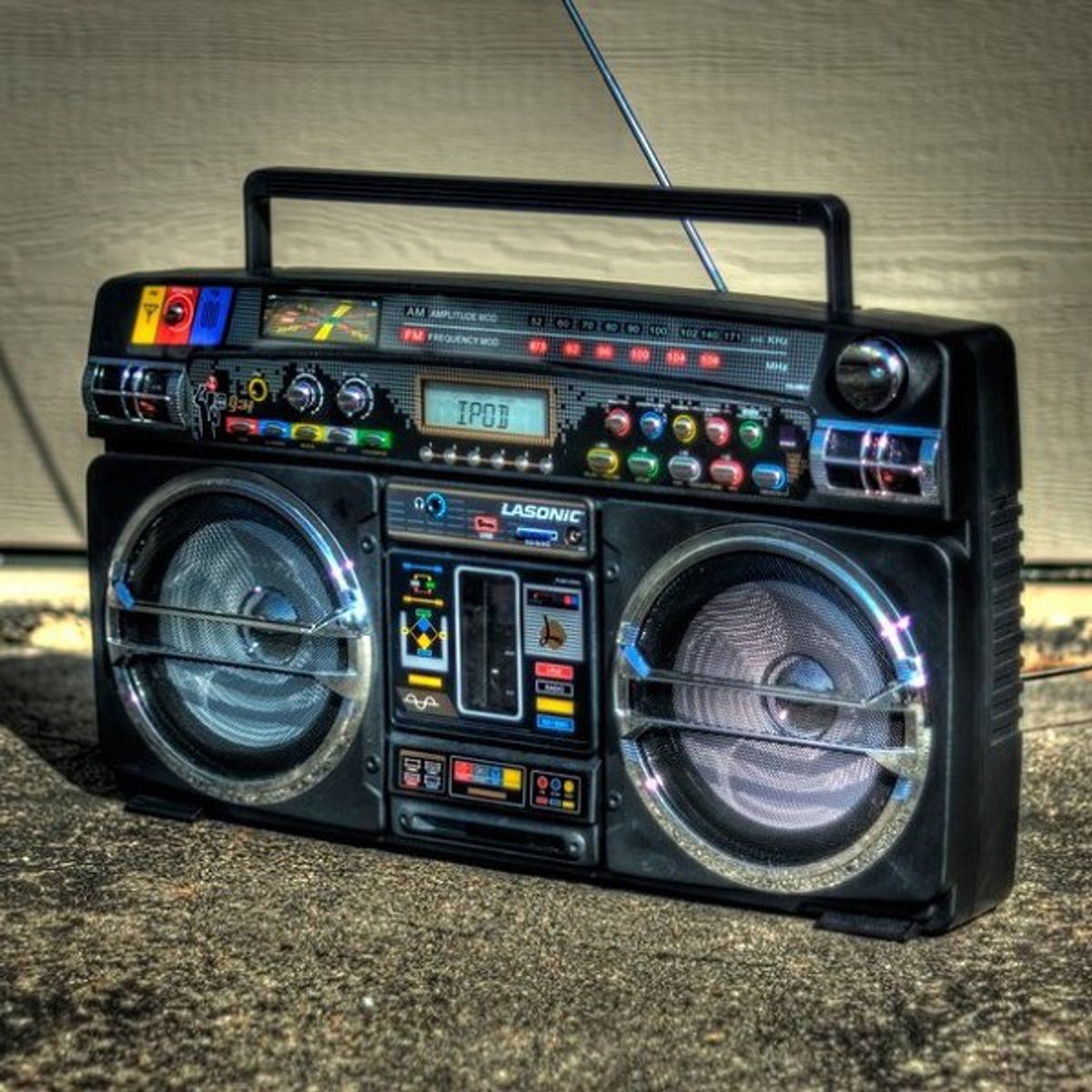Now, I have the everlasting joy of explaining the Norse creation myth. To be honest, it can be a bit kooky, so talking about it is always fun. The entire cosmos is included in this creation myth, not just the earth but the sun and the moon as well. This will be a short retelling, a summary of the creation myth, somewhat like I did with Hermod's ride to Hel.

The Norse cosmos began with two worlds, Niflheim and Muspellheim. These two worlds, the worlds of primordial cold and fire, were separated by a great fissure called Ginnungagap. The waters from the well Hvergelmir, at the center of Niflheim, by many rivers flowed into Ginnungagap and "when those rivers, which are called Elivagar, came so far from their source, the poisonous flow hardened like a slag of cinders running from a furnace, and became ice. ...Then layer by layer, the ice grew within Ginnungagap" (Byock 13). The northernmost regions of the gap filled with hoar frost and rime, but the southernmost were "the regions bordering on Muspell [and] were warm and bright" (Byock 13). Where the cold of Niflheim's ice and the warmth of Muspellheim's fire met in Ginnungagap the ice thawed, and "there was a quickening in these flowing drops and life sprang up" (Byock 14). From the ice came Ymir, known as Aurgelmir by the giants, the origin of all frost giants. As the wise giant Vafthruthnir says, "'down from Elivagar did venom drop, / And waxed till a giant it was; / And thence arose our giants' race, / And thus so fierce are we found'" (Bellows 76-77).
A Cow, Some Gods, and a Murder

After Ymir was formed, the primeval cow Audhumla formed "as the icy rime dripped" and "four rivers of milk ran from her udders, and she nourished Ymir" (Byock 15). Audhumla licked at the salty rime for nourishment, and as she licked "these stones of icy rime the first day, the hair of a man appeared," then "on the second day came the man's head, and on the third day, the whole man" (Byock 15). This man was Buri or Bur, the first god. Buri "had a son called Bor, who took as his wife the woman called Bestla" who was the daughter of the giant Bolthorn (Byock 15). Bor and Bestla had three sons, Odin, Vili, and Ve.
These sons then killed Ymir, and "when he fell, so much blood gushed from his wounds that with it they drowned all the race of the frost giants except for one who escaped with his household" (Byock 15). This giant was Bergelmir, who escaped in a boat with his wife, and so "from them come the races of the frost giants" (Byock 16).
Then Odin, Vili, and Ve "took Ymir and they moved him into the middle of Ginnungagap and made from him the world" (Byock 16). And so "Out of Ymir's flesh was fashioned the earth, / And the mountains were made of his bones; / The sky from the frost-cold giant's skull, / And the ocean out of his blood" (Bellows 74). And "they made stones and gravel from the teeth, the molars and those bones that were broken," "took his skull and from it made the sky" with a dwarf at each corner to hold it up (named North, South, East, and West) (Byock 16). These gods took the sparks from Muspellheim and made them into the stars, moon, and sun, and "it is said in the old sources that, from then on, times of day were differentiated and the course of the year was set" (Byock 17). As well, "[Midgard] the gods from [Ymir's] eyebrows made, / And set for the sons of men; / And out of his brain the baleful clouds / They made to move on high" (Bellows 101). And so the world was created.
The Creation of Man, Night, and Day
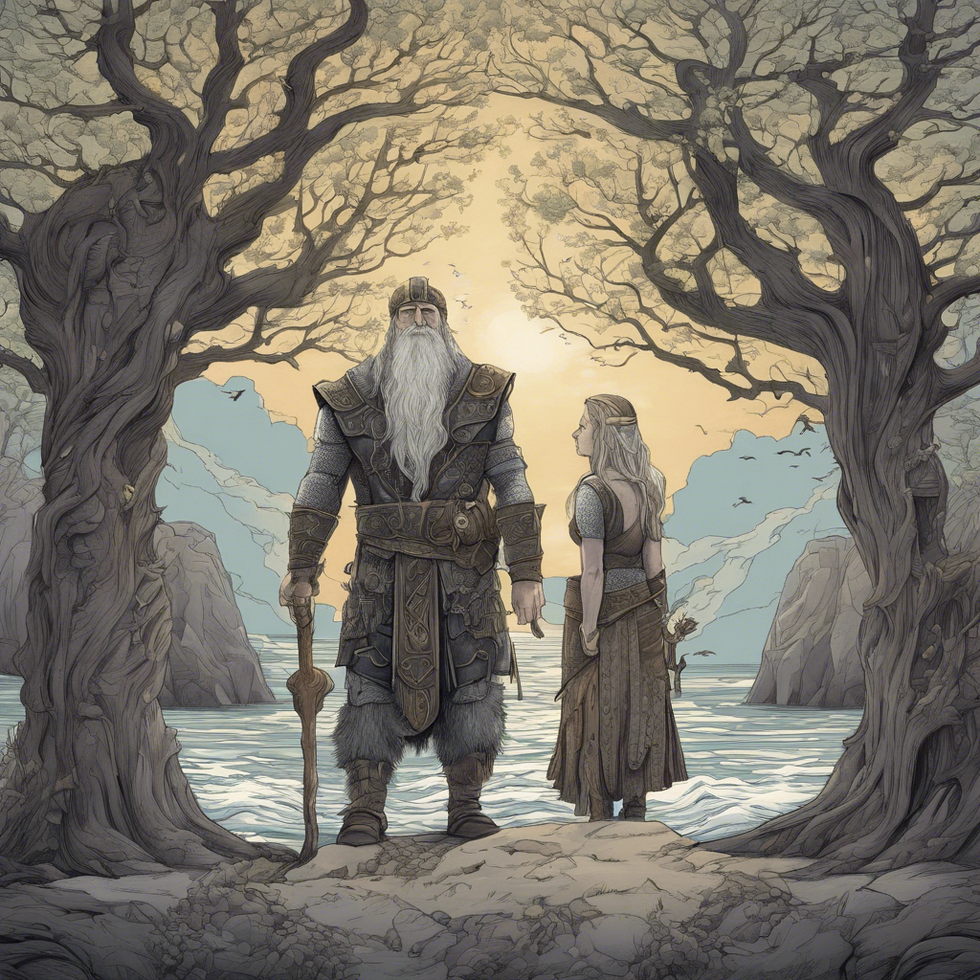
Man was created when Odin, Vili, and Ve "were once walking along the seashore and found two trees." They took the logs and created humans from them: "The first son gave them breath and life; the second, intelligence and movement; the third, form, speech, hearing, and sight." These gods even "gave them clothing and names." There were the man Ask and the woman Embla, and "from them came mankind and they were given a home behind Midgard's wall." The gods then went on to make Asgard. Odin began to rule over Asgard and sire the gods known as the Aesir. (All quotations in this paragraph are from Byock 18.)
A giant named Norfi had a daughter named Night "who was black and swarthy like her kinsmen." Night was married three times; first, to Naglfari, with a son called Aud; second, to Annar, with a daughter called Earth; and third, to Delling, "who was from the family of the gods." Night and Delling had a son called Day, "and he was as bright and beautiful as his father's people." Odin took Night and Day, gave them horses and chariots, "and placed them in the sky to ride around the earth." Night rides Hrimfaxi (Frost Mane) "and every morning foam from the horse's bit sprinkles the earth," while Day rides Skinfaxi (Shining Mane) "and with its mane it lights up all the sky and the earth." (All quotations in this paragraph are from Byock 19.)
"'The father of day is Delling called,
And the night was begotten by Nor;
Full moon and old by the gods were fashioned,
To tell the time for men.'" (Bellows 75)
The Sun and Moon
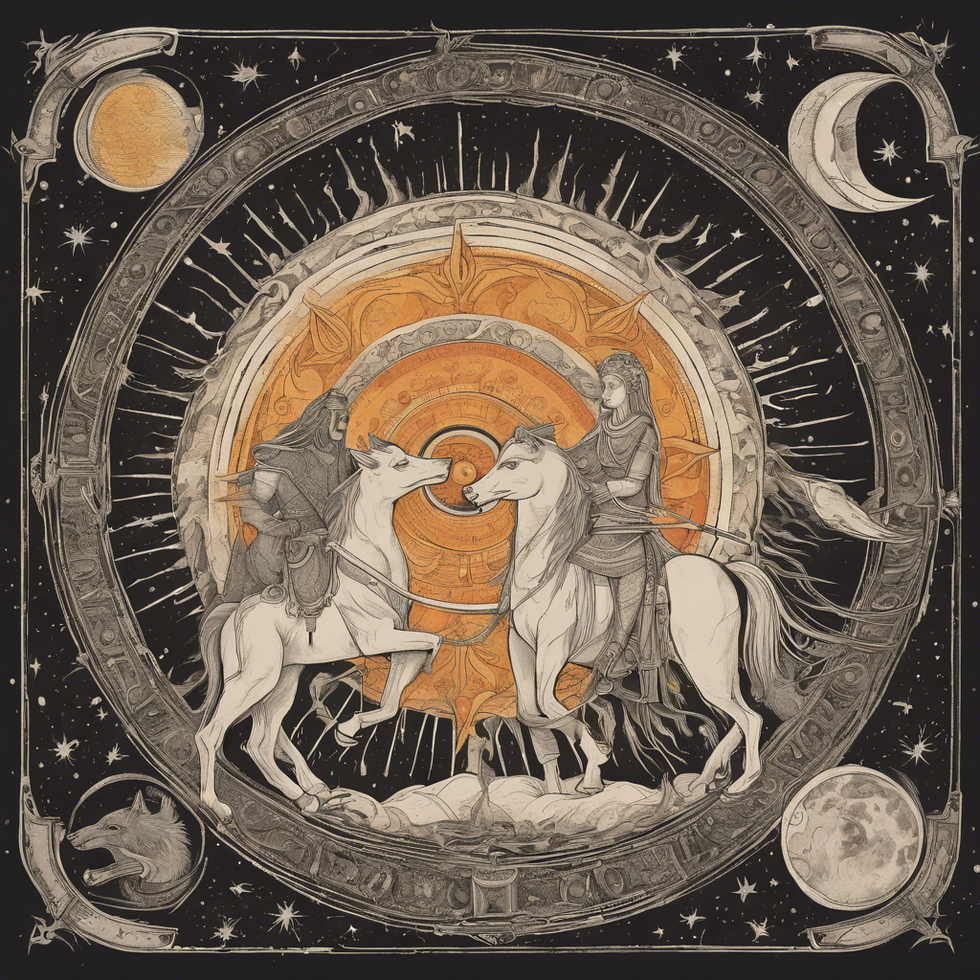
The sun and the moon were fathered by a man named Mundilfari. These children were "so fair and beautiful that he called one Moon [Mani] and the other, a daughter, he called Sun [Sol]" (Byock 19). Mundilfari married his daughter Sol to a man named Glen, which angered the gods. So, the gods took the siblings and placed them in the heavens. "There they made Sun drive the horses that drew the chariot of the sun" while "Mani guides the path of the moon and controls its waxing and waning" (Byock 19). The two horses "Arvak and Alsvith up shall drag / Weary the weight of the sun; / But an iron cool have the kindly gods / Of yore set under their yokes" (Bellows 99). This iron cool refers to the bellows Isarnkol placed under their shoulders to cool the horses. The sun, fashioned from the embers and sparks of Muspellheim, is so hot that "in front of the sun does Svalin stand, / The shield for the shining god; / Mountains and sea would be set in flames / If it fell from before the sun" (Bellows 100). For clarity, Svalin is a shield that Sun carries to protect the world from the heat of the sun. Sun and Moon are chased by two wolves, which is why they move so quickly in the sky. The one that chases Sun is called Skol, who "frightens her, and he will eventually catch her" (Byock 20). The one that chases Moon is Hati Hrodvitnisson.
"'Mundilferi is he who begat the moon,
And fathered the flaming sun;
The round of heaven each day they run,
To tell the time for men.'" (Bellows 74)
So that's the cosmos. The Norse creation myth reminds me a lot of the Greek creation myth given the overthrowing of a giant-figure by the ones he created. What I find interesting is that, as far as I know, the creation of Yggdrasil is not mentioned. This just reasserts Yggdrasil's place as an integral pillar to the cosmos; it has likely always been there, before Ymir and before the gods created any other realms.
What do you all think?
Keep creating, my friends.
- 11 Strange Creatures People Actually Believed In ›
- "The Belgariad" And What Sets It Apart: A Book Review ›
- The Secret Story Behind 'The Emperor's New Groove' ›
- Women are the cornerstone of the universe ›
- All About Norse Mythology: The Plan ›





 shiny things
StableDiffusion
shiny things
StableDiffusion
 listen to your heart
StableDiffusion
listen to your heart
StableDiffusion
 face your fear
StableDiffusion
face your fear
StableDiffusion
 olympic woman
StableDiffusion
olympic woman
StableDiffusion
 Lessons of life
StableDiffusion
Lessons of life
StableDiffusion
 Woman praying
StableDiffusion
Woman praying
StableDiffusion
 Disneys Goofy
StableDiffusion
Disneys Goofy
StableDiffusion
 love
StableDiffusion
love
StableDiffusion
 you are stronger than you think
StableDiffusion
you are stronger than you think
StableDiffusion
 kindness
StableDiffusion
kindness
StableDiffusion

 StableDiffusion
StableDiffusion
 StableDiffusion
StableDiffusion
 StableDiffusion
StableDiffusion
 StableDiffusion
StableDiffusion
 StableDiffusion
StableDiffusion
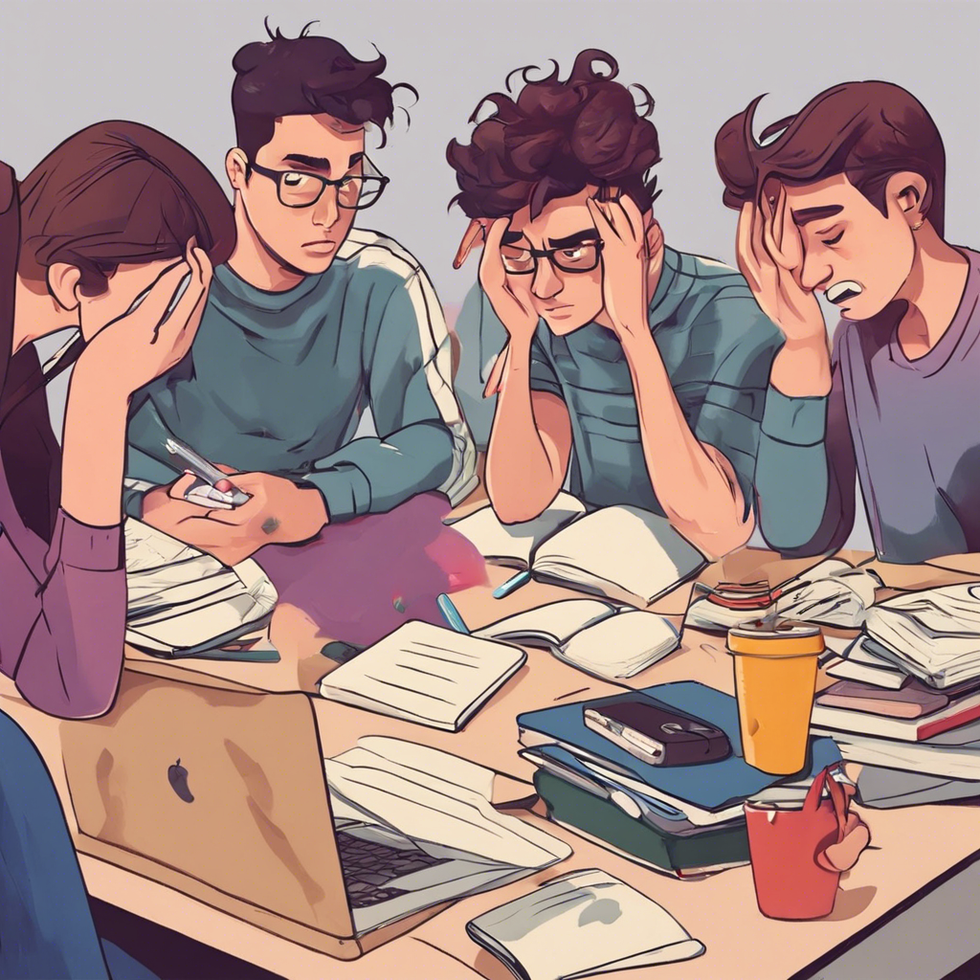 StableDiffusion
StableDiffusion
 StableDiffusion
StableDiffusion


 StableDiffusion
StableDiffusion
 StableDiffusion
StableDiffusion
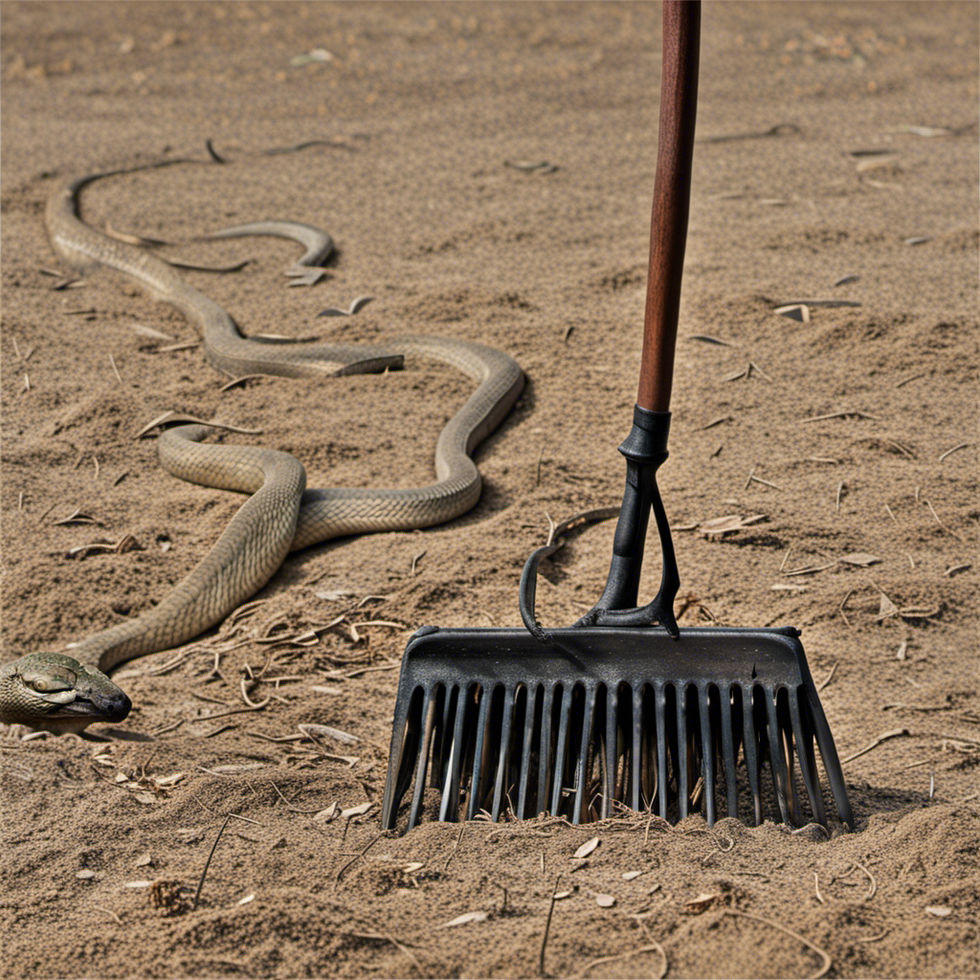
 StableDiffusion
StableDiffusion

 StableDiffusion
StableDiffusion

 StableDiffusion
StableDiffusion

 StableDiffusion
StableDiffusion

 StableDiffusion
StableDiffusion
 StableDiffusion
StableDiffusion
